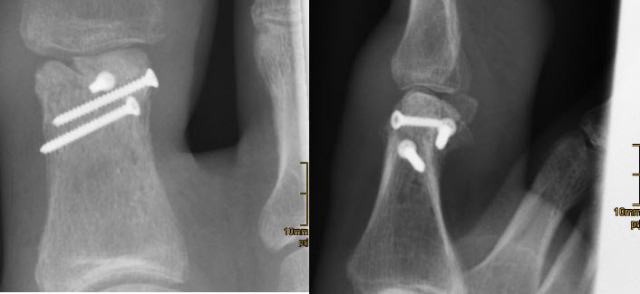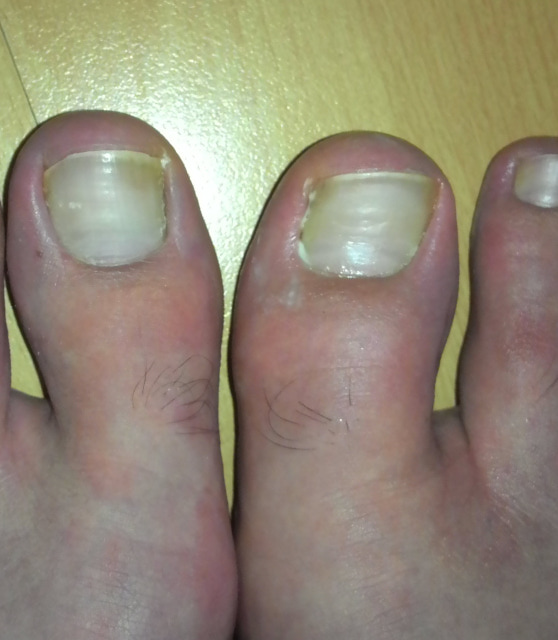Question X-ray
X-ray
 Picture
Picture
QUESTION: Good day to you, Mr Jairo Cruz,
it has been 8 months since my right hallux surgery (proximal phalanx joint) with 3 pins as in the x-ray (as of March). My toe is still quite stiff and high below the nail area, but also downwards as you can see in the other pic.
Can you tell me whether the pins are well-positioned and optimal for recovery or if the edges are the reasons for the swelling, as well as what I can do to regain the natural thickness and flexibility of my malformed toe (it hurts a bit underneath after certain pressure).
I am long done with physiotherapy and shoe-sole changes. I can walk quite normally, but I feel there is something there that pulls and "scratches" the area. In the mornings, the toe looks thinner and more natural than in the evenings or after jogging. Is this a good or a bad sign? Can, for example, acupuncture help?
Finally, if the pins must be removed, is it a more difficult operation than what has already been done (I just heard so)? How can I exhaust all options of modern technology before letting myself in the clinic again?
Thank you for your precious knowledge and time.
Have a nice day.
ANSWER: Hello Michael,
Sorry for the delay in my response. It seems that you had quite a bit of work on that toe. Judging by the one view on the X-ray there is a bit of separation of the bone and therefore you could be suffering from a non-union of the fracture fragments. If the original surgery was completed for a fracture then the non-union makes sense. The hardware will have to come out and the fracture/non-union will be cleaned up and reapproximated into proper alignment. Fixation will be used to hold that fragment in place. This is of course assuming the rest of the bone is stable. I am assuming it is because you are jogging and if the bone was fragile it would have shattered. Fusion of your big toe may be necessary in the future because arthritis will occur at that joint.
The hardware in the toe could also be causing pain and swelling especially if it is in the joint. On the X-ray they look like they are properly placed. Hardware can cause swelling and should be removed if necessary.
I do not see any signs of infection and I am assuming there is no opening in the skin.
My advice is to go see a podiatrist. Have them assess your foot and then you will have to decide whether or not you want the surgery.
The other option is to place a bone stimulator over the site and hope that the gap gets filled. This is unlikely but since it is 9 months past your surgery date you may be able to get it approved with your insurance. I am hopeful that your surgeon has documented the non-union.
I hope this information helps.
Best Regards,
Dr. Jairo Cruz Jr
www.thetampapodiatrist.com
Twitter: @drcruz4feet
---------- FOLLOW-UP ----------
QUESTION: Neither the surgeon nor the controlling doctors told me anything about that non-union. In fact, during my stay at the clinic the surgeon told me that the pins shouldn't disturb me and that they are intended to stay there. But I guess that every surgeon would put it like that in order to calm down the patient and to avoid suspicious statements from possible faults from his side. What can I say.
So, are there risks in removing those pins? Is it an easier operation than to drill them in? And what about acupuncture? Can it help reduce that stiffness and thickness?
Thank you again, Dr Cruz
AnswerMichael,
Understand that I am not trying to go against what your doctors are saying. I am simply telling you what I see on the x-ray and interpreting your description, but my opinion is limited due to not physically examining you. That being said, I would get a third opinion. The risk involving pin removal is infection and increased pain. Anything could happen technically but infection is at the top of the list of complications. Acupuncture: I have no experience with so I cannot offer my opinion on that treatment. Physical therapy will help assuming there is movement of the joint. Steroid injections, iontophoresis, ultrasound, super pulse laser, and other conservative options may be helpful as well.



